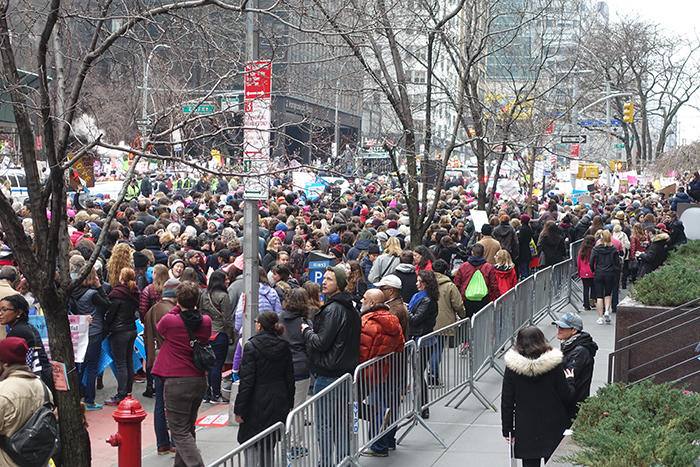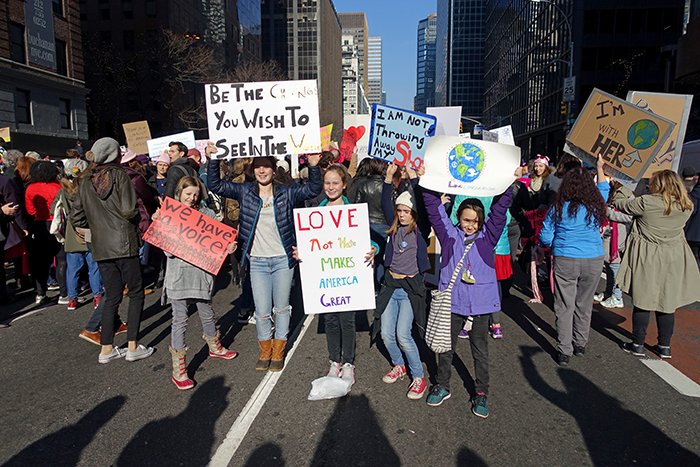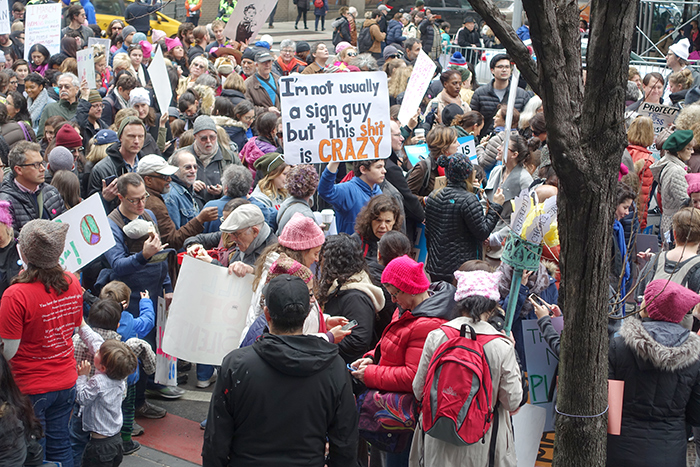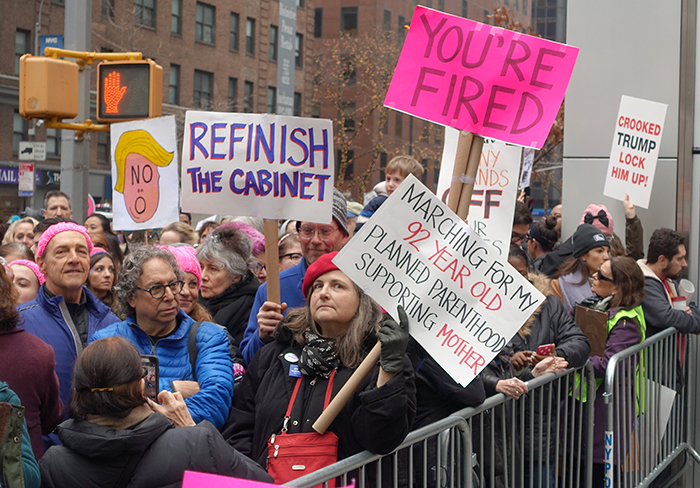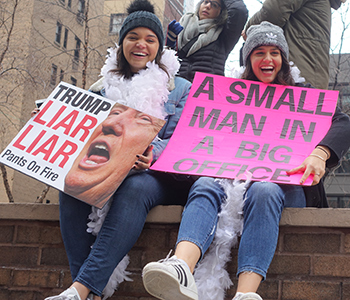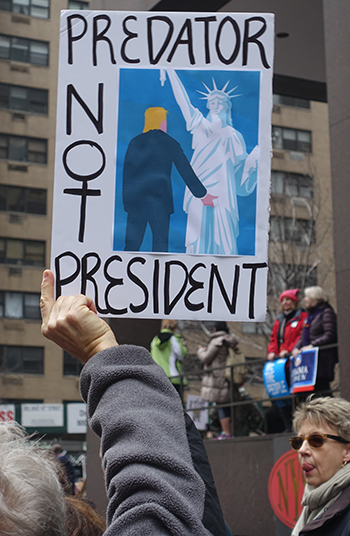Taking It to the Streets: Marchers Swamp Midtown Manhattan |
|||
| Text & Photos by Kate Mueller | |||
|
|||
The day of the inauguration was, I felt, studiously ignored by New Yorkers. I had traveled to the city two days before to attend the march on Saturday, January 21, and spend sometime visiting friends in a city that is like a second home to me, having lived there during my 20s. New Yorkers went about their daily lives per usual. If anything, I detected a pall over the city, in keeping with the gray sky that day. On my way to Washington Square Park around noon, with street vendor sandwich in hand, I observed a group of Quakers under the arch with sign unfurled: “Pray for Peace.” They were standing vigil at the exact moment of Trump’s swearing in. While I sat on a park bench eating my sandwich, I overheard two old guys playing chess mutter to each other about “that schmuck” being sworn into the White House. Later, I passed a church in Greenwich Village with a sign out front inviting passersby to enter for prayer and meditation, from noon to three. Not exactly a party atmosphere. Mind you, this is a purely subjective interpretation but one borne out by a New York Times article I read later that documented mostly disinterest or disgruntlement on inauguration day, with a few celebratory pockets, notably on Staten Island, the only borough where Trump won the vote. (But oh yeah, that’s all fake news.) |
|||
|
|||
The following day in the city, the day of the big march in Washington, DC, with many sister marches not just in the US but around the world, was markedly different. About 75,000 people had been projected to attend the New York march, an estimate based in part on how many had officially registered, but more than five times that many showed up on the streets—over 400,000, according to Mayor Bill de Blasio’s office. Organizers of the women’s march put the tally closer to 600,000. Whatever the number, there were a lot of people in midtown—filling the streets and avenues and bringing traffic to a standstill. The mood was festive and enthusiastic, full of warmth, camaraderie, and humor—mirroring marches around the country and the world. I set out with my friend, Manhattanite Susan Bernhard, a choreographer and dance teacher, at about 10:30 a.m. for Dag Hammerskjold Plaza at East 47th Street and First Avenue, where the march was to begin and the rally held. The plan was for the march to go south on Second Avenue, turn west on 42nd Street, and then north on Fifth Avenue, ending just short of Trump Tower at 55th Street. |
|||
|
|||
We didn’t even attempt to get to the rally; we took the train uptown and walked to 46th Street, where we mostly stood. Over the course of an hour and a half, we inched our way east to Second Ave, traversing maybe 25 feet during that time. We fell into and out of random conversations with our neighbors. I overheard an animated conversation among a half-dozen women, hailing from New York, Connecticut, and New Jersey. They expressed dismay that most of the country didn’t know Trump like they knew Trump—living in the tri-state area and witnessing upfront and center his shenanigans. Didn’t these folks notice how much Trump, who comes from Queens, was disliked and had been voted down by his hometown? Didn’t that send a message, they wondered? Seventy-nine percent of all New Yorkers voted for Hillary Clinton, and in Manhattan that percentage rose to over 86 percent. |
|||
|
|||
After waiting patiently to get to Second Avenue, the message came to do an about-face. Second Ave was completely jammed, and we were to take an alternate route up Third. We walked back over our hard-earned 20-some feet. That was the first indication that the parade route had been abandoned. On Third, we made good time and observed folks choosing whatever cross street they liked to head west to Fifth. All of midtown was fair game. Once at Fifth, we realized, as one of the errant splinter groups, that we were marching outside the barriers—but that no longer mattered. The cops were few, and they were relaxed, chatting and joking with marchers. As we walked past St. Thomas Episcopal Church at 53rd, at about 2:45 p.m., the bells in the church clanged out “The Star-Spangled Banner.” Someone was playing for us, cheering us on! The marchers sang heartily. The national anthem was followed by “This Land Is Your Land,” and we continued singing. I wondered who was doing this, and soon a door high up in the vast façade of this Gothic-style church opened, and the barely visible figure of a woman appeared, waving to the enthusiastic marchers. I was disappointed that we were unable to march right up to Trump Tower. A barricade at 55th Street stopped us, and we were told to turn east and leave the march. I peered up the avenue and could make out security personnel in yellow vests swarming around the base of the tower. I joined a group of marchers who pointed at the tower and chanted in unison “Shame! Shame! Shame!” |
|||
|
Bernhard joined the march “to oppose Trump and his cronies and to show women’s power.” She was “stunned” by the size of the crowd, noting that the march “was totally peaceful and even the police looked relaxed.” Vermonters Claire Benedict, coowner of Bear Pond Books in Montpelier, and Montpelier writer Coleen Kearon also attended the march. Benedict and Kearon marched with members of Benedict’s family who live in New Jersey: her sister, 29-year-old niece, and 83-year-old mother. Kearon says they did very little actual marching: after gathering with others at 48th street, they essentially stood for two and a half hours, barely moving forward. Finally, the police directed them to turn back. |
||
|
|||
|
Kate Mueller, editor of Vermont Woman newspaper, lives in Montpelier.
|
||
